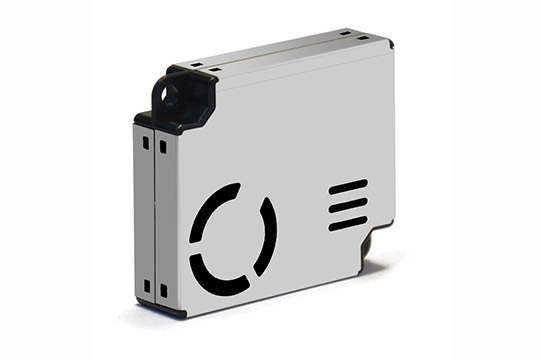Classification and Principles of Common Gas Sensors
Views:273 Updated:2025-05-27
Gas sensors are critical devices used to detect and measure the concentration of various gases, ensuring safety and environmental monitoring. They are classified based on their working principles, each suited for specific applications. Below are the primary types and their underlying principles:
1. Electrochemical Sensors Principle: Utilize redox reactions between the target gas and electrodes in an electrolyte. Gas diffuses through a membrane to the working electrode, undergoing oxidation/reduction. This generates a current proportional to gas concentration.
Key Components: Working, counter, and reference electrodes; electrolyte.
Gases Detected: Toxic gases (CO, Cl₂, H₂S, NO₂).
Advantages: High sensitivity, low power consumption.
Limitations: Limited lifespan, cross-sensitivity to other gases.
2. Semiconductor (Metal Oxide) Sensors
Principle: Rely on changes in electrical resistance of metal oxides (e.g., SnO₂) when exposed to gases. Heating the material (200–400°C) allows gas adsorption, altering resistance.
Mechanism: Reducing gases (e.g., CH₄) decrease resistance (n-type), while oxidizing gases (e.g., O₃) increase it.
Gases Detected: Combustible gases (LPG, methane), VOCs.
Advantages: Broad detection range, cost-effective.
Limitations: High power consumption, affected by humidity.
3.Catalytic Bead (Pellistor) Sensors
Principle: Detect combustion via heat from gas oxidation on a catalyst-coated bead. A platinum coil’s resistance changes with temperature, measured against a reference bead in a Wheatstone bridge.
Gases Detected: Combustible gases (methane, propane) within explosive limits (LEL).
Advantages: Robust for explosive environments.
Limitations: Poisoning by silicones or lead, requires oxygen.
Principle: Utilize redox reactions between the target gas and electrodes in an electrolyte. Gas diffuses through a membrane to the working electrode, undergoing oxidation/reduction. This generates a current proportional to gas concentration.
Key Components: Working, counter, and reference electrodes; electrolyte.
Gases Detected: Toxic gases (CO, Cl₂, H₂S, NO₂).
Advantages: High sensitivity, low power consumption.
Limitations: Limited lifespan, cross-sensitivity to other gases.
2. Semiconductor (Metal Oxide) Sensors
Principle: Rely on changes in electrical resistance of metal oxides (e.g., SnO₂) when exposed to gases. Heating the material (200–400°C) allows gas adsorption, altering resistance.
Mechanism: Reducing gases (e.g., CH₄) decrease resistance (n-type), while oxidizing gases (e.g., O₃) increase it.
Gases Detected: Combustible gases (LPG, methane), VOCs.
Advantages: Broad detection range, cost-effective.
Limitations: High power consumption, affected by humidity.
3.Catalytic Bead (Pellistor) Sensors
Principle: Detect combustion via heat from gas oxidation on a catalyst-coated bead. A platinum coil’s resistance changes with temperature, measured against a reference bead in a Wheatstone bridge.
Gases Detected: Combustible gases (methane, propane) within explosive limits (LEL).
Advantages: Robust for explosive environments.
Limitations: Poisoning by silicones or lead, requires oxygen.
 4. Infrared (IR) Sensors
Principle: Measure gas-specific IR absorption. A detector compares attenuated IR light at absorption wavelengths to a reference.
Types: Non-dispersive IR (NDIR) is common.
Gases Detected: CO₂, hydrocarbons, methane.
Limitations: Limited to gases with IR-active.
5. Photoionization Detectors (PID)
Principle: Ionize gas molecules using UV light. Ion current correlates with concentration.
Key Requirement: Gas ionization potential < UV photon energy (e.g., 10.6 eV lamps).
Gases Detected: VOCs (benzene, toluene), some toxics.
Advantages: High sensitivity for low-concentration VOCs.
Limitations: Cannot detect inert gases (e.g., CO₂, CH₄).
6. Other Types
Thermal Conductivity Sensors: Detect gases with thermal conductivity distinct from air (e.g., H₂, He).
Ultrasonic Sensors: Identify gas leaks via sound waves.
Colorimetric Tubes: Chemical reaction-induced color change for spot sampling.
Each sensor type excels in specific scenarios, balancing sensitivity, selectivity, and environmental robustness. The choice depends on the target gas, required precision, and operational conditions.
4. Infrared (IR) Sensors
Principle: Measure gas-specific IR absorption. A detector compares attenuated IR light at absorption wavelengths to a reference.
Types: Non-dispersive IR (NDIR) is common.
Gases Detected: CO₂, hydrocarbons, methane.
Limitations: Limited to gases with IR-active.
5. Photoionization Detectors (PID)
Principle: Ionize gas molecules using UV light. Ion current correlates with concentration.
Key Requirement: Gas ionization potential < UV photon energy (e.g., 10.6 eV lamps).
Gases Detected: VOCs (benzene, toluene), some toxics.
Advantages: High sensitivity for low-concentration VOCs.
Limitations: Cannot detect inert gases (e.g., CO₂, CH₄).
6. Other Types
Thermal Conductivity Sensors: Detect gases with thermal conductivity distinct from air (e.g., H₂, He).
Ultrasonic Sensors: Identify gas leaks via sound waves.
Colorimetric Tubes: Chemical reaction-induced color change for spot sampling.
Each sensor type excels in specific scenarios, balancing sensitivity, selectivity, and environmental robustness. The choice depends on the target gas, required precision, and operational conditions.

